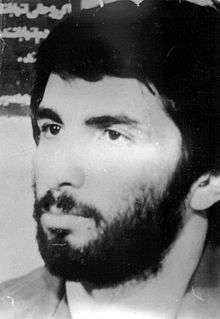Mohammad Jahanara
| Seyyed Mohammad Ali Jahan Ara | |
|---|---|
 | |
| Born |
31 August 1954 Khorramshahr, Khuzestan, Iran |
| Died |
29 September 1981 (aged 27) Kahrizak, Tehran, Iran |
| Allegiance | Iran |
| Service/ | Islamic Revolutionary Guard Corps |
| Commands held | Khorramshahr IRGC |
| Battles/wars | |
Seyyed Mohammad Ali Jahanara (Persian: سید محمدعلی جهانآرا) was the Iranian commander of the Islamic Revolutionary Guard Corps in Khorramshahr during the Iran-Iraq War. He was killed the 1980 Iranian Air Force Lockheed C-130 crash in Kahrizak, along with the Iranian senior military commanders.[1][2]
History

Jahanara was born on 31 August 1954 in Khoramshahr, Khozestan. He started his political and religious activities with some of his friends in Khoramshahr's Imam Sadegh mosque when he was 15 years old. In 1971, Jahanara and his brother joined the secret group of "Hezbollah", which was involved in a political campaign against the Shah, Mohammad Reza Pahlavi, in Khoramshahr. 2 years later, members of Hezbollah group was identified and arrested by SAVAK, and Jahanara was sentenced to one year in prison.[1][3]
After graduating from high school in 1975, Jahanara went to the Tabriz School of Business and continued his political activities. He eventually joined the armed militant "Mansoron" group. Jahanara was involved in political activities in different cities such as Tehran, Kashan, Ghom, Yazd, and Isfahan. SAVAK killed his brother, Ali Jahanara, in 1978. In spring and summer of 1978, Jahanara was responsible for dispatching a group to Syria and Palestine for participation in special militant training. Jahanara actively participated in the 1979 Revolution in his birthplace. After the victory of the Iranian Revolution and establishment of AGIR in 1980, he was selected as commander of Khoramshahr AGIR and established the Jihad of Construction (Persian:جهاد سازندگی) in Khoramshahr.[2][3] He was married to a woman named Akbarnejad in 1979.[4]
Battle of Khorramshahr
The Battle of Khorramshahr was a major engagement between Iraq and Iran in the Iran-Iraq War. The battle started from September 22 until November 10, 1980. Known for its brutality and violent conditions, the city came to be known by the Iranians as Khuninshahr, meaning "City of Blood". The Pasdaran commander, Mohammed Jahanara, was one of the last few soldiers to leave Khorramshahr when it fell to the Iraqis. He would go on to fight in the Siege of Abadan and lead Iranian forces to liberate Khorramshahr. He died before the city was liberated on May 24. A popular song was later written in his commemoration, saying, "Mamad, you weren't here to see that our city is liberated."[5]
Further reading
- Pedram Khosronejad (13 September 2013). Unburied Memories Politics Sacred Defense Martyrs Iran. Routledge. pp. 157–. ISBN 978-1-135-71160-3.
References
- 1 2 "زندگینامه: محمدعلی جهانآرا". hamshahrionline.ir. Retrieved 17 February 2015.
- 1 2 "سردار سرلشكر پاسدار شهید محمدعلی جهانآرا". tebyan.net. Retrieved 17 February 2015.
- 1 2 "زندگینامه شهيد محمدعلی جهانآرا". aviny.com. Retrieved 17 February 2015.
- ↑ "گفتگو با خانم اکبرنژاد، همسر سردار شهید سید محمد جهانآرا". hawzah.net. Retrieved 17 February 2015.
- ↑ McLaurin, R. D. (July 1982). "Military Operations in the Gulf War: The Battle of Khorramshahr" (PDF). U.S. Army Human Engineering Laboratory: 24. Retrieved 25 August 2012.
| Wikimedia Commons has media related to Mohammad Jahanara. |